Interview: Siegfried Hecker on remembering history while planning the future of nuclear arms control
By John Mecklin | December 7, 2020
Interview: Siegfried Hecker on remembering history while planning the future of nuclear arms control
By John Mecklin | December 7, 2020
Sig Hecker is one of the world’s foremost nuclear security and policy experts and has for decades served as a go-to source for journalists writing about nuclear affairs. An emeritus fellow at Stanford’s Freeman Spogli Institute for International Studies and the former director of Los Alamos National Laboratory, Hecker has a long history of working to foster cooperation on nuclear issues between US and Russian scientists and their governments. He has visited North Korea and toured various of its nuclear facilities multiple times and is at work on a book about that country.
In mid-October, a few weeks before the 2020 presidential election, I asked Hecker to talk with me about arms control and disarmament. Particularly, I wanted to know what he thought could and should be done in the future—particularly, in the next decade or so—to restore and extend an arms control regime that has deteriorated in the last few years, as the United States and Russia have withdrawn serially from major arms control agreements and let New START come to the brink of expiration.
In short, I asked him to look forward, rather than back, and to suggest concrete actions world leaders can take now to reduce nuclear risk. Hecker quickly and rightly reminded me that planning the future without taking account of the relevant history is unlikely to produce success.
You mentioned you want to point the reader of this issue of the Bulletin to the future, but I must say, I think one of the most important things that the Bulletin does is to make sure that we don’t forget the past, and actually that we can learn the lessons from the past.
So, as far as arms control, I think what really is important is to learn from the lessons of the past. And let me actually start with a comment that was made by Alexey Arbatov, who is one of the great strategic thinkers in the world, a Russian. When he wrote about the concern of the demise of arms control, what he pointed out was the current state leaders and the foreign policy elite—they came to positions of influence mostly in the beginning of this century or later. And they inherited for free what he calls “the legacy of an arms control system built during the previous few decades.”

And what they’ve done is taken that for granted and treated that as a pawn in a game of foreign and domestic politics. They have only a vague idea of a world without such a system and don’t know or credit the history of dangerous crises and wasteful cycles of the nuclear arms race during the Cold War.
That, I think, captures the essence of the problem that we have today. We have leaders and elites in place who don’t appreciate what the arms control regime has actually done for us. So, as I look back and I try to construct an arms control vision of the future, I’m actually reminded by the very simple but important principles that Thomas Schelling and Morton Halperin put forth in a key article back in 1961. And what they said was: “Our military relation with potential enemies is not one of pure conflict or opposition, and therefore we need to do arms control.”
They gave three reasons for doing arms control. One, is to reduce the likelihood of war. Two, is to reduce the destruction if war occurs. And three, to reduce the burden in peace time for being ready for war. So, as I look at the overall situation, those three principles are still key.
Those are still the overall principles. What we need to do is to tailor those to the current times. I don’t think we need to invent anything new. The power structures have changed, the countries have changed. But the principles are the same. For me, arms control is still extremely important for the reasons that Schelling and Halperin pointed out.
John Mecklin:
Okay, but you have a set of leaders who don’t necessarily believe what you just said or are thinking of it in an entirely different way. Is there a way that scientists can help bring governments around to refocusing on those central issues?
Siegfried Hecker:
In my opinion, the scientists remain crucial. Actually, in the early parts of the arms control regime, the scientists were mostly brought in after arms control agreements or treaties were already signed. And they were brought in to make sure that, “Hey, can we actually do this? Can we verify it?” Later on, particularly as we came to the dissolution of the Soviet Union, the scientists actually had an opportunity to shape some of the future. And I think that’s important. Learning from that time during the dissolution of the Soviet Union, what the scientists can do is, scientist to scientist, they can build trust. Through their interaction you build a lot more transparency, which is very, very important. And particularly important when it comes to verification.
Then the other part, particularly one that I’ve been very much involved in and I’ll get to that when we discuss North Korea, is to inject into the political system what I call “technically informed risk-benefit analysis.” In other words, what’s really important? Don’t just stick to the politics and the ideologies, but try to do risk management. And base that risk management on what the technical analysis actually tells you. That, of course, then has to be combined with the policies and politics. But it has to be injected early in the process.
And that’s why the scientists are important. And we’ve demonstrated the importance of scientists-to-scientists cooperation with the Russians, what we called lab the “lab to lab.” It was crucial in helping to deal with the new dangers as the Soviet Union dissolved. And we’ve done very similar things with China, for example. So, that will be very important in the future.
John Mecklin:
You are an advocate of international cooperation on nuclear weapons and nuclear power. Much of the successful cooperation in these spheres occurred in a very different political time. Is nuclear cooperation between the US and Russia possible with Vladimir Putin as Russia’s president?
Siegfried Hecker:
Yes, but it will be different. The most successful cooperation was during the 1990s after the breakup of the Soviet Union. We cooperated to help Russia deal with the enormous nuclear legacy of the Soviet Union. In my book, Doomed to Cooperate, I called it the four loose nukes problem—nuclear weapons, nuclear materials, nuclear experts, and nuclear exports. The problem of these nuclear assets not getting out of the control of the Russian government was huge because of the immense scale of the Soviet nuclear program—39,000 nuclear weapons, nearly 1.5 million kilograms of fissile materials, and one million people employed in the nuclear programs, all in a country in political, economic and cultural chaos.
Cooperation worked, but Putin has changed the narrative of success to claim that the US took advantage of a weak Russia in the 1990s. He claims falsely that the US used cooperation to get access to all of their secrets. Future cooperation will have to be structured not as an assistance program, but as mutually beneficial threat reduction. We thought that’s what we were doing during the Cooperative Threat Reduction Program, but Putin has his own narrative, and we are not going to change that.
In Doomed to Cooperate, I made the point that in the nuclear world we must cooperate to get the benefits of nuclear energy and avoid the dangers. Thus, we still have a huge spectrum of things on which we must cooperate with the Russians, and for that matter, the Chinese. These include avoiding nuclear confrontation, preventing nuclear proliferation and nuclear terrorism, safeguarding nuclear materials, mitigating the environmental consequences of all things nuclear, and expanding nuclear power globally safely and securely.
Cooperation in all of these areas is beneficial to both countries and is still quite achievable. But it will be difficult to step back from the current competitive nuclear weapons modernization programs and arms race. This will take major political will on both sides.
John Mecklin:
The notion that bilateral arms control isn’t good enough anymore, that, the Trump administration is saying, China has to be brought into this, it has to be multilateral—does that make sense to you at all? I mean, has the world changed in a way that these negotiations should be in a multilateral forum?
Siegfried Hecker:
The answer is yes, China has to be brought into looking at the overall situation. Because we’re not dealing with a rising China anymore. China has risen. China is one of the great powers. It’s become a great power primarily because of its economy. Fortunately, China has not achieved that great power status by building up its nuclear arsenal. And what we need to make sure of is that it doesn’t go in that direction. And to do so, you have to include China in the dialogue.
However, what you should not do is what we’re currently pushing under this US administration—and that is to just bring China into what was designed as a bilateral process. You’ve got two powers that are limited by their agreements to 1,550 strategic nuclear weapons. And you’ve got China sitting there with, we don’t know exactly how many, but on the order of 300 total warheads, a few dozen of which are strategic nuclear weapons.
I have discussed this with Chinese colleagues, both technical as well as policy people, and they say, “Hey, look, we’re not getting into that. This is not the right dialogue to have.” What you have to do is not try to include China in an extension of New START. But rather, go ahead and extend New START with the Russians, and then over the next five years or so bring the Chinese into the discussion, actually asking them, “Hey, what’s crucial to you in terms of overall arms controls?” So that we get the benefits that Schelling and Halperin talked about.
In my discussions with the Chinese, for example, what they will tell you is, “Look, we have limited number of strategic nuclear capabilities, and we need to make sure that we have an assured second-strike capability. What threatens our second strike is your ballistic missile defense activities.” Therefore, we have to talk to them about ballistic missile defense. How do you structure it? How do you do that in a way that China actually feels reasonably secure with its current or somewhat modernized arsenal but not by going up to 1,550 warheads, for example.
The other interesting aspect of what I heard from the Chinese when I discussed with them precisely this issue, about coming in on a New START extension, and they said right off the bat, “We’re just, we’re not doing that. However, we’re certainly willing to discuss the future arms control issues, particularly if you bring the UK and France into this.” And that would be the right way to do that, because now rather than looking at sort of trading off and worrying about what China does with respect to the US and Russia, now you have the five nuclear powers.
John Mecklin:
That sort of bridges into something you’ve spent a lot of time on, North Korea. I mean, obviously the missile defense aspect you’re talking about with China in some regards relates to North Korea. How the United States has handled the North Korea situation has been interesting to watch, but extremely unusual for the last few years. Why don’t you give me your view of what’s happened up til now, and your assessment, if you were advising the next president. Whoever that is, here’s what you think they should do about North Korea and its nuclear weapons.
Siegfried Hecker:
Again, this is a case where I’d like to go back and say let’s make sure we learn the lessons of history. Because if you just start with where we are with North Korea today, and you try to project what’s going to happen over the next 10 years, I don’t think you have much of a chance. On the other hand, if you go back over the last 30 years and take a look as to what has actually happened. And as you indicate, it’s not just the last couple of years that’s discouraging. It’s the past 20 years, at least. Or we can go back into the ‘90s, the past 30 years.
So here is North Korea, a pretty small, destitute country, and it has now developed a nuclear arsenal that is threatening. And they’ve done six nuclear tests, as many as India and Pakistan. And they have done those six nuclear tests over a period of seven years, so they’ve actually learned much. They have a very ambitious missile program.
We look back over 30 years and you say, “How can this destitute little country, essentially against all odds, develop a nuclear arsenal?” And actually, it’s not just against all odds, but almost in plain sight. They’ve actually had me in North Korea seven times and showed me their nuclear capabilities. Because they wanted the United States and the world to know. They wanted, I’m sure, to impress them with the fact that they have a deterrent.
When I first went in 2004 what they called their deterrent was the piece of plutonium they allowed me to hold. In a sealed glass jar, of course. You know, that’s as much of a deterrent as they had. But here we are now 16 years later, and they have enough nuclear materials for maybe around 40 or so nuclear weapons. They have a few tens of kilograms of plutonium and perhaps just shy of a thousand kilograms of highly enriched uranium. So how in the world did they get there?
And I’m going to get to answer your question by saying, as we look at the history the most important thing is to realize that what North Korea has done since around 1990 is to say, “Look, we’re going to try diplomacy.” Because in 1990, around that time, at the end of the Cold War, their world fell apart. Their major benefactors, the Soviet Union and China, essentially cut them loose. And so Kim Il-sung, the Great Leader of North Korea as they called him, at that time actually made the decision that he was going to explore a strategic alignment with the United States of America. That perhaps those guys, the Americans, will be more reliable for us than the Chinese or the Russians could be, by 1992.
So, diplomacy was clearly one of the paths that he wanted to explore. However, being this small country— obviously being paranoid, security not at all assured—he also took a second path, and that is nuclearization. The way that I view it, he developed diplomacy and the nuclear program in parallel. And depending on what the other side did, he would weigh one higher than the other.
And you look at the Clinton administration, that’s when dialogue was ahead. But, the North Koreans never gave up also developing the nuclear path. So, they hedged. They froze the plutonium program, but they hedged with a centrifuge program [for enriching uranium]. And the Clinton administration, I should say, almost got there, with diplomacy leading. Almost got there.
But then the Bush administration and the neo-cons came in, and their view was very much like that in Iraq, and Libya, and other places, “These are rogue regimes that you don’t deal with.” “You don’t deal with evil, you destroy it,” those were vice-president Cheney’s words. And so they killed the dialogue part. North Korea responded by saying, “Well, they just killed the dialogue, so we’ll move the nuclear aspirations up.” And they did. They restarted their nuclear complex, manufactured more plutonium, tested their first nuclear device in 2006.
The Obama administration was going to put diplomacy first, however this was at a very difficult time for North Korea. When Kim Jong-il, the Dear Leader as they called him, had a stroke in August of 2008, they worried about succession planning, and so they were determined to do a second nuclear test. Well, they more or less greeted Obama with that. That pretty much took care of the eight years of the Obama administration. Consequently, there wasn’t much diplomacy.
Then President Trump comes in and during the first year, 2017, I think it’s fair to say almost everything just went to hell. The North Koreans had already put nuclearization ahead of diplomacy during the Obama administration. They conducted two more nuclear tests in 2016 to close out the Obama years. In 2017, they then went ahead and conducted what was most likely a hydrogen bomb test. And during President Trump’s first year in office, they test launched three ICBM’s. So nuclearization was ahead.
Then Trump in 2018 makes the switch to diplomacy with the Singapore Summit, which many people have criticized. In my opinion, it was actually exactly the right step to take. It was the right first step. Unfortunately, it also wound up to be the last step, because the Trump administration didn’t play the rest of the hand well. So, we went back to nuclearization again.
As I look back, I begin to understand that the North Koreans have essentially followed this dual path, and they’re not going to give up the nuclear path until diplomacy can get them to the point where they would feel secure.
This is a very long-winded way to get to your question, “What do we do next?” Don’t keep saying we’re going to denuclearize, and we’re going to put maximum pressure on North Korea to have them denuclearize. It hasn’t worked. It will not work. The best you can do, in my opinion, is to get back to what I call technically-informed risk-benefit analysis. Get them to step back one piece at a time and roll back the risks that they actually pose. And instead of using sanctions to apply maximum pressure, use sanctions relief to actually allow them to see the benefits that they could get from diplomacy.
It was just before the Singapore Summit in June of 2018, my colleagues and I laid out a framework that said, “It’ll take 10 years, maybe 15,” and what needs to be done is to systematically, comprehensively go through and work with the North Koreans, in three phases. Halt—in other words if you’re in a hole, stop digging. Don’t let it get worse. Second, roll back [the North’s nuclear program] a piece at a time. And then third, finally eliminate. And don’t just call it “denuclearization.” What we’re after, is the elimination of nuclear weapons and the means to produce and to deliver them.
You’re going to have to recognize it will take a long time, it isn’t going to happen by some election timeframe. But, I think the chances are still there, it’s just even more difficult today than it should have been by the year 2000. That’s a long answer but North Korea is a complex problem.
John Mecklin:
It’s become really clear to me that you support nuclear power as a way of dealing with climate change. And there are a lot of scientists that do. My question, and I think it’s probably going to be my last question is: Given what’s happened with North Korea, how do you increase the use of nuclear power around the world without creating more nuclear weapons states? I mean, countries have used nuclear power programs as screens for developing nuclear weapons. Is it even possible to have much greater use of nuclear power around the world without proliferation problems?
Siegfried Hecker:
I think that the importance of increased nuclear power around the globe is such that we must find a way to have both nuclear power and to move toward the elimination of nuclear weapons, or at least to avoid any more proliferation to additional states.
Again, if we look at history here, actually John, nuclear power programs—nuclear electricity and nuclear medicine—haven’t really led to nuclear weapons. Okay? Of course, we have the P5; let’s put those countries—the US, Russia, China, UK, and France—aside. Beyond those, let’s say we go to India and Pakistan. Was it the fact that they were building big nuclear reactors, nuclear electricity that led to their nuclear weapons program? In my opinion, no.
Did they use the fact that they had a civilian nuclear program to help them in a nuclear weapons program? The answer is yes. And the Indians were probably the worst in this, because they actually did the 1974 nuclear explosion, which they called a “peaceful nuclear explosion” with plutonium produced in what was a civilian reactor built by the Canadians and partially supplied by the US. But, of course, a nuclear device is a nuclear device; it will ruin your day, one way or another. So, the Indians were the worst.
But, even there, I think India actually should have a much larger civilian nuclear power program, because they’re polluting India and polluting the globe. And, at this point they have nuclear weapons. Pakistan’s nuclear weapons program had very little to do with Pakistani nuclear electricity and nuclear medicine. In North Korea, also, it actually very little to do with that. They built a separate nuclear weapon program.
All of those had some civilian nuclear energy capabilities. And there’s no question that when you have a nuclear reactor, you have people who’ve been educated in nuclear physics or nuclear engineering, that certainly affects the latency. In other words, it will make it easier to make the jump into nuclear weapons. But it’s not, in my opinion, the automatic step from civilian nuclear to nuclear weapons.
As you well know, there are two parts to this problem. One is the supply part, and the other, the demand part. On the supply side, having a civilian nuclear program of any kind will indeed help you to move in that direction if you wanted to. But the main effort really has to be on the demand side. In other words, why do countries want nuclear weapons? That’s the part that we have to work on. We need to work much more on the whole international non-proliferation regime. By the regime, I don’t mean just the Non-Proliferation Treaty or the IAEA [International Atomic Energy Agency]. I mean everything associated with that, including the issue of alliances, and so forth. So, in my opinion, it is possible and desirable to have nuclear power and still control the dangers associated with the development of nuclear weapons.
John Mecklin:
Okay. I said that was my last question, but I’m a journalist so I get to ask one more. The nuclear ban treaty almost certainly will go into effect within the next months, maybe the next weeks. What effect do you think that will have, if any? Is it going to mean anything to the world nuclear situation, or is it just a feel-good something that a bunch of countries that don’t have nuclear weapons all decided to do?
Siegfried Hecker:
John, I’m not a fan of the treaty at this point. I don’t think that’s the best way to make the world a safer place. I would actually change your question a little bit to something that I think we do need to think a lot more about. And that is: “Is a world without nuclear weapons even possible?” Not just through this treaty, but through any mechanism.
My view is that it remains the long-term goal and, of course, a lot of those people who have signed that treaty will say, “Yeah, that’s what you guys have said all along.” But, I think it’s important to say the long-term goal is there, the elimination of nuclear weapons, but I personally think that the world is not yet ready for the total elimination of nuclear weapons.
For the immediate future what, in my opinion, the objective should be is a world without nuclear conflict. And that’s difficult enough. And so, John, that’s where I have spent most of my time in the last 30 years. It is s not to try to get rid of all nuclear weapons, because I didn’t know how to do that, but I thought it was possible not to have a nuclear conflict. And we’re fortunate enough today we haven’t had a nuclear conflict, and we haven’t had nuclear weapons used since Hiroshima and Nagasaki.
Stanford University’s Francis Fukuyama, who you know well is one of the greatest strategists of today, he’s actually stated, “In today’s world nuclear weapons provide restraint.” And I think that’s really important. If you look at the US, Russia, China—I don’t see how we’re going to get rid of those conflicts anytime in the next decade or so. Not because of the current leadership of Putin, Xi Jinping, and Trump. But just because there’s competition. We see the world in different ways, we’re going to have competition. And how do we make sure that that competition doesn’t turn into terrible bloodshed, a global catastrophe? And Francis Fukuyama believes, and I certainly believe, that nuclear weapons provide restraint.
But what sort of nuclear weapons arsenal do you need in order to provide that restraint? That’s what I think we need to work on. And that’s where cooperation comes into play. That is where we, particularly the three big powers, actually go back to the Gorbachev-Reagan dictum that said a nuclear war cannot be won, so a nuclear war should not be fought.
I think all three of us can agree that that’s important. And then within the spirit of knowing that we don’t want to start a nuclear war, what levels can you actually draw your arsenals down to? How can you change the structure? How do you get arms control agreements into place that will limit the potential buildup? How do you do this in such a way that it is restraint that the nuclear weapons provide, rather than moving towards an escalation? Which, I’m afraid is where we are today.
So, the zero part. When I teach, I discuss that with my students. I give them essentially the same story: “I just don’t see how we can go to zero today.” However, the one thing that I also tell them, though, is: “The long-range goal has to be zero.” Even though we all realize we don’t know exactly how to verify that. But the goal has to be zero. Because there are two questions that I ask: “If it’s not zero, what’s the number?”
Okay, give me a number. Is it five? Is it 10? Is it 100? What’s the number? The even more difficult question is, “Who gets to have them?” Is it the United States and Russia, or China? Or is it the countries that have nuclear weapons today? You know, who gets to have the nuclear weapons? There is no good answer, beyond zero, and you don’t get to have them. So that’s eventually the world that I see we need to move toward. However, in the meantime, I’m going to put my energies into making sure that we have a world without nuclear conflict.
Together, we make the world safer.
The Bulletin elevates expert voices above the noise. But as an independent nonprofit organization, our operations depend on the support of readers like you. Help us continue to deliver quality journalism that holds leaders accountable. Your support of our work at any level is important. In return, we promise our coverage will be understandable, influential, vigilant, solution-oriented, and fair-minded. Together we can make a difference.

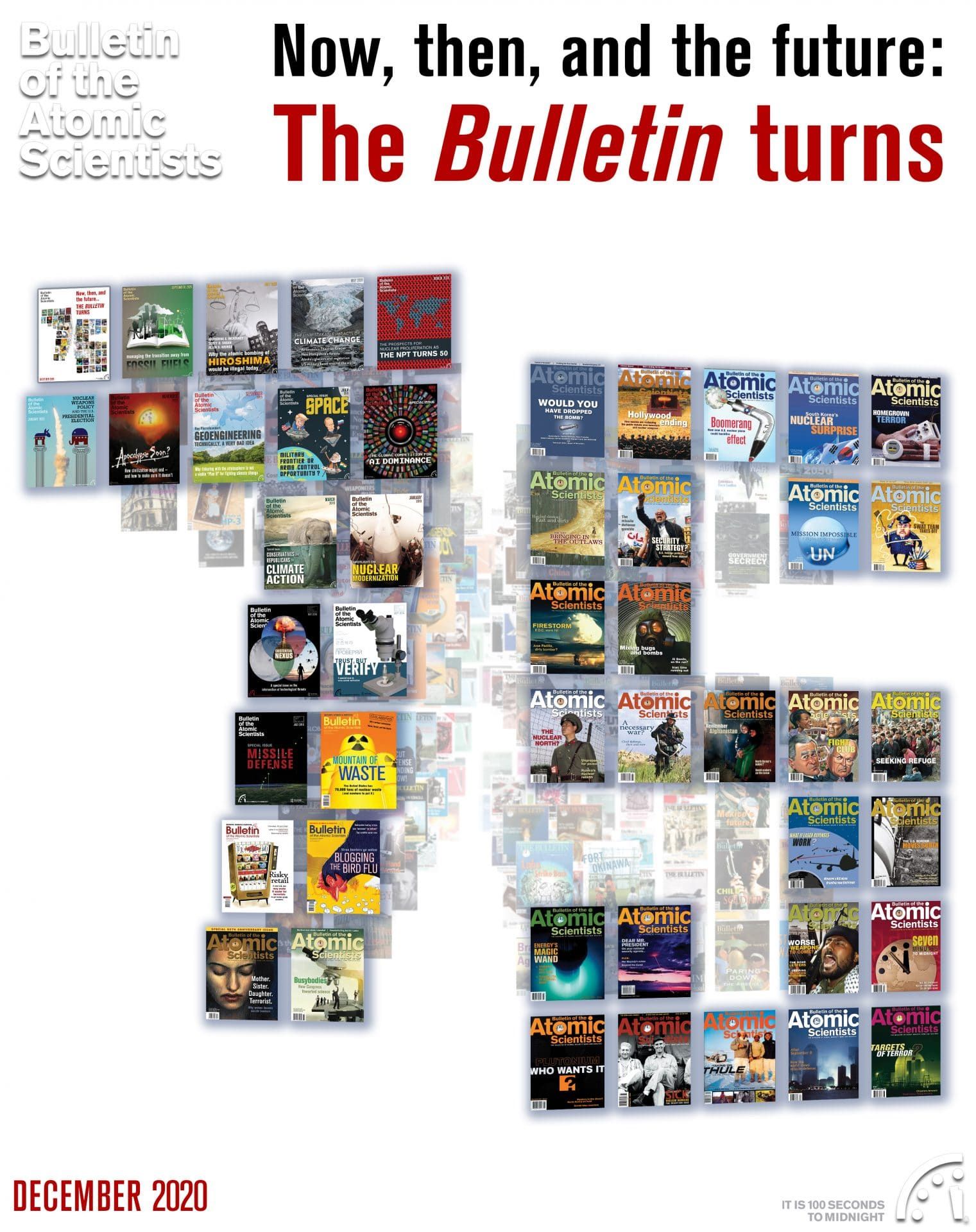



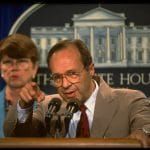
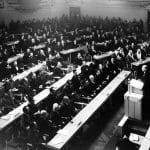
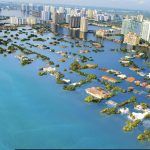
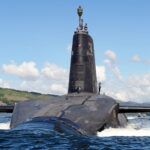

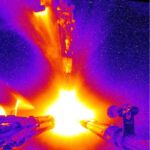
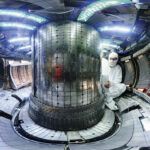









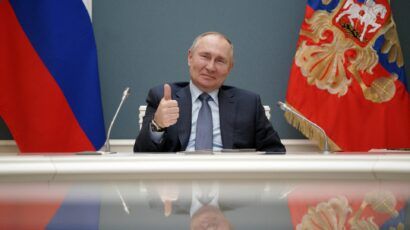
It would be progressive to have articles on topics such as these: – 1970s Kissinger, Cheney, Rumsfeld’s urging US Universities to aid Iran’s nuclear programs when Shah openly aiming to develop nuclear weapons – 1989 after Iran-Iraq war Bush snr invited Iraqi engineers to US for advanced training in weapons production – Presence of US nuclear weapons on Diego Garcia – 1991 Security Council resolution banning nuclear weapons in Middle East commits US & Britain to work for a nuclear-weapons-free zone there blocked by Obama in 2015 to stop Israel’s nuclear arsenal from coming under inspection. Imperils the Non-Proliferation Treaty… Read more »